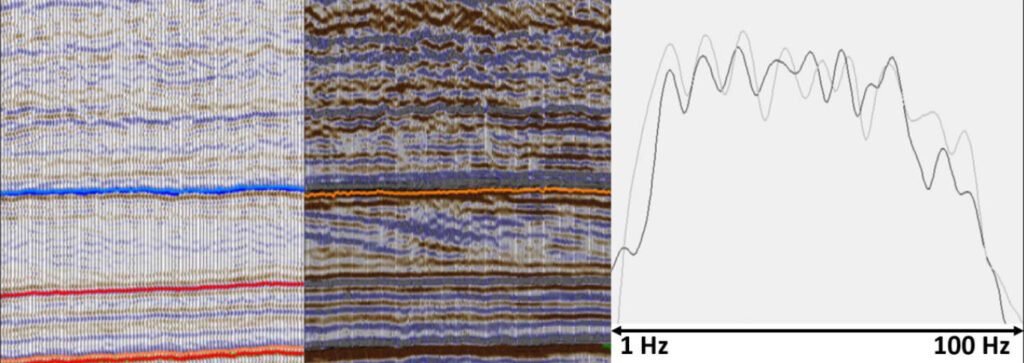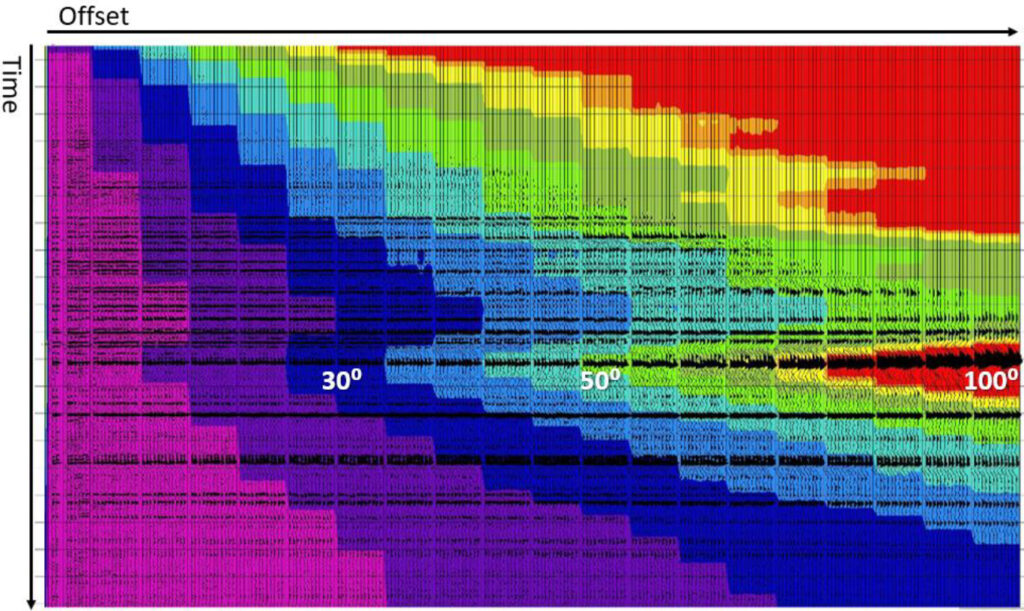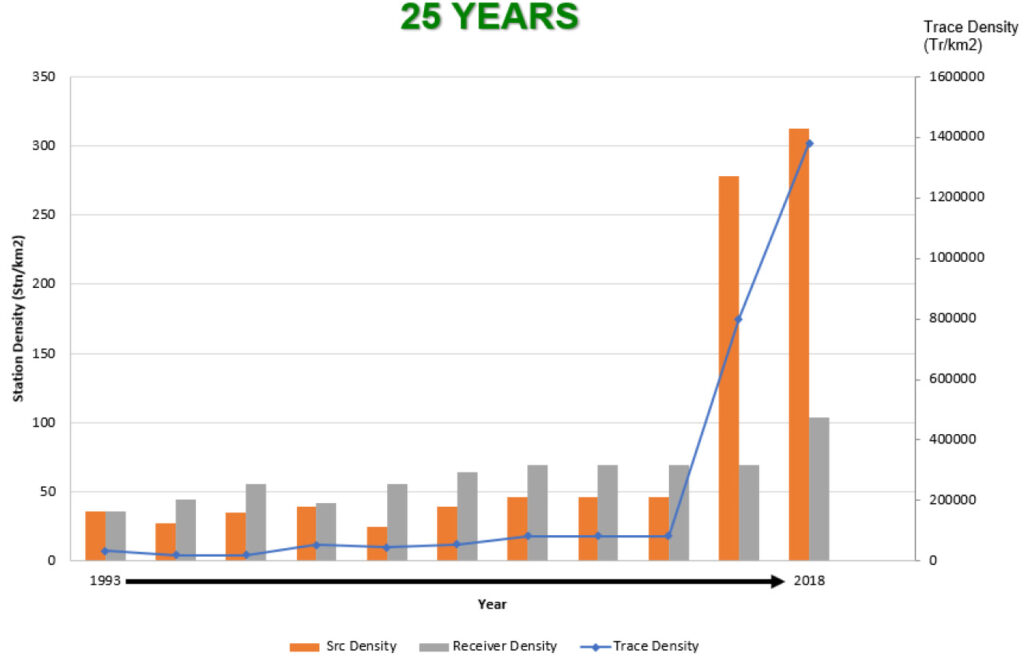Andrea Crook OptiSeis Solutions Ltd.
Rob McGrory, Nathan Baker, & Adam Westlake, Crescent Point Energy
Summary
In general, seismic acquisition in the Western Canadian Sedimentary Basin (WCSB) has been conducted using primarily explosive sources, whereas vibroseis acquisition has been limited to areas with relatively flat topography. With the recent advances in seismic acquisition and processing technology, vibroseis sources are beginning to replace explosive sources even in areas where traditionally all seismic acquisition has been explosive (O’Byrne et al., 2016, Crook, 2018). In this case study we review the process of transitioning from explosive source seismic acquisition to high density vibroseis acquisition.
Method
Seismic acquisition in the WCSB has been extremely successful with numerous wells drilled and barrels of oil produced. Many of these surveys were acquired with an explosive source, so the question is, why change to high density vibroseis? The answer can be summed up in two words: resolution and cost. With high density vibroseis acquisition, a four to ten times increase in trace density can be achieved for the same cost as an explosive survey (depending on source parameters and source station density).
However, vibroseis acquisition has been perceived in the WCSB as being a “riskier” source with weaker signal strength and poorly defined first breaks. The question then becomes, how do you mitigate the perceived risks of vibroseis acquisition? Here, the answer is testing and trace density.
In the area of the case study, all the surveys over the past 25 years except for one were acquired with an explosive source. Some improvements in resolution were achieved by increasing the receiver and source density, but trace density at target remained relatively low (20-30,000 tr/km2 at target). The data from these surveys were adequate for mapping and delineating conventional resources by focusing on the necessary imaging to resolve gross structure; however, the resolution and wavelet stability is less than optimal for modern work flows for unconventional resource development where pre-stack inversion is routine. Higher resolution explosive surveys were proposed, but the costs of drilling proved prohibitive due to market conditions.
Although high density vibroseis techniques such as slip sweep and simultaneous source have become commonplace outside of the WCSB (Berkhout, 2008, Howe et al., 2008, El-Taha et al., 2018) the mediocre quality of the only vibroseis survey within the project area made switching to vibroseis acquisition risky. To mitigate the risks, a series of tests were implemented in three different areas over the course of several years. These tests included acquiring 2D slip sweep test lines (Rozemond, 1996) with varying parameters, acquiring a small high density vibroseis 3D concurrent with an explosive 3D, processing decimation tests to determine optimal trace density, a thorough acquisition design analysis focused on subsurface imaging requirements, and extensive start-up tests to select optimal sweep parameters prior to starting acquisition.
Results
The initial testing had mixed results with ground conditions and signal-to-noise ratio having an impact on trace density requirements for high density vibroseis acquisition. As a result, the proposed survey in the case study area was designed with 7.5x the trace density (at target) of the adjacent explosive survey. Figure 1 illustrates the difference between the new high density vibroseis survey and the adjacent explosive survey. Improvements were obtained in both the low frequencies (a 1.5 Hz start frequency was utilized) and high frequencies (high trace density contributed to improved noise removal in processing). Early comparable results from pre-stack inversion show great promise but are ongoing as of submission time for this abstract.
Due to the success of this project, a second high-density vibroseis survey was was acquired with 17x the trace density (at target) of the adjacent explosive 3D (Figure 3). With the move to high density vibroseis acquisition, the limiting factor on both field efficiency and cost has become the receiver stations. Although simultaneous source acquisition would enable the implementation of a smaller source station, it would not solve the equipment bottleneck. Future testing will involve examining receiver station density and implementing a form of simultaneous source acquisition.
Results
High density vibroseis acquisition can provide significant benefits in terms of improved seismic resolution and reduced costs when compared with an equivalent explosive survey. It is worth investing in testing and analysis to determine optimal geometry and vibroseis parameters when implementing high density vibroseis surveys. As seismic acquisition technology continues to advance, further improvements in resolution and costs are expected.
Acknowledgements
The authors would like to thank Crescent Point Energy for permission to share these results and the following companies for helping with the design, acquisition, and processing of these datasets: Absolute Imaging, Earth Signal, Echo Seismic, Key Seismic, OptiSeis Solutions Ltd., and SAExploration.

Figure 1: A comparison of an explosive source survey (left), and a high-density vibroseis survey (middle). Amplitude spectra (right) indicate that high density vibroseis (grey spectrum) can improve both low and high frequency content.

Figure 2: A Common Offset Common Azimuth (COCA) gather from a high density vibroseis survey illustrating usable offsets out to 50-80 degrees.

Figure 3: A comparison of source, receiver, and trace density for surveys within the case study area. The final two surveys on the right were acquired with high density vibroseis acquisition.
References
Berkhout, G., 2008, Changing the mindset in seismic data acquisition: The Leading Edge, 27, 924–938.
Crook, A., 2018, Seismic Acquisition Innovations Applied in Canada: The Recorder, 43, no. 5.
El-Taha, Y.C. and May, R. (2018). Seismic with simultaneous sources: Where does the industry stand? The Leading Edge, 37(4), 300-302.
Howe D., Foster M., Allen T., Taylor B., and Jack I., 2008, Independent simultaneous sweeping – a method to increase the productivity of land seismic crews: 78th Annual International Meeting, SEG, Expanded Abstracts, 2826-2830.
O’Byrne, A., MacNeil, G., and Kura, A., 2016, Field Testing Justifying Significant Changes in 3D Design Parameters to Improve Seismic Data and Decrease Costs: The RECORDER, 41, no. 7
Rozemond, H., 1996, Slip-sweep acquisition. SEG Technical Program Expanded Abstracts 1996: pp. 64-67.

